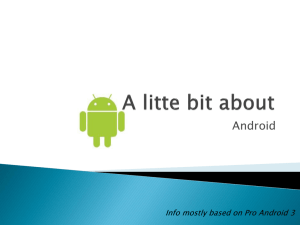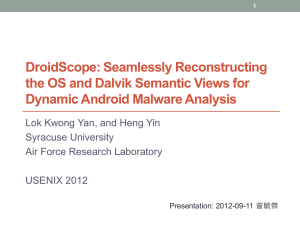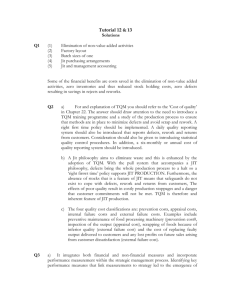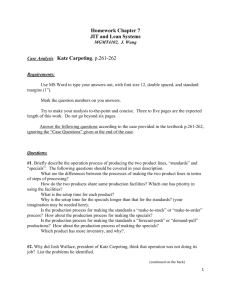Student presentation
advertisement
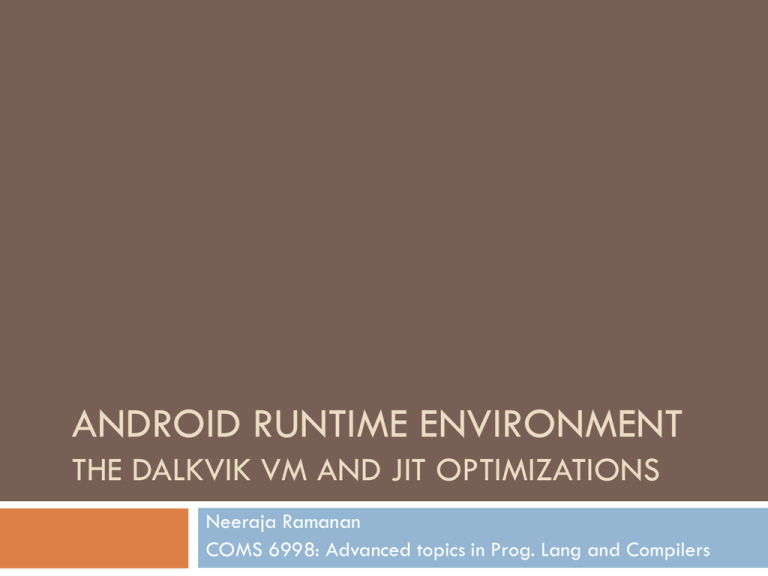
ANDROID RUNTIME ENVIRONMENT THE DALKVIK VM AND JIT OPTIMIZATIONS Neeraja Ramanan COMS 6998: Advanced topics in Prog. Lang and Compilers Overview A brief (yet, hopefully comprehensive) overview of Android Runtime system The Dalvik VM A little more detail Contrast with JVMs JIT compiler in Dalvik Nice to know Keeping in mind the audience, keeping it brief The focus of this lecture The JIT flow Demo – Runtime execution Questions and Discussion What is Android? Android is a Linux-based operating system designed primarily for touchscreen mobile devices such as smartphones and tablets, developed by Google in conjunction with the Open Handset Alliance Some history… Open Handset Alliance (OHA) 84 firms Open standards for mobile devices Google, HTC, Sony, Dell, Qualcomm, Intel, T-Mobile, etc Beta version of SDK - 2007 Commercial product – HTC Dream – 2008 – Cupcake Android! Growth Everyday more than 1 million Android devices are activated worldwide – source http://developer.android.com App store downloads: 1.5 billion per month Open-source code base: 3.6M to 17.1M lines of code in 3.5 years Iterative development New versions – biannual Annual flagship device Version History Image Source: http://developer.android.com About a few apps Google Nexus Flagship -> pure Android experience Mix-up the OEMs now and then Open-source As seen on Android Market – 10/01/2012 Structure of an App Hello Dalvik Temple Run Top 25 Downloaded Free App Good benchmark Rendering of landscape Calculation of nodes Stresses everything on the phone Also, fun to test! Screenshots Image Source: Android Market Introduction to logcat Built-in logging tool View the system logs as and when they occur Best way to diagnose a problem Sometimes, only way! Screenshot And now to business… Anatomy of the Android Image Source: http://marakana.com/static/slides/android_for_enterprise/index.html Why the Linux kernel? Memory and process management Permission space and security model Open source! But its not Linux Not a windowing system Does not have glib c support Lots of Linux functionality not present On Start-up init – similar to Linux Starts the daemons which run the basic device drivers Also starts zygote Zygote – nascent process at system boot time Initializes system libraries and loads it on to one dalvik This then starts the different modules on the framework Then wait for socket requests from runtime processes Forks new VM instances for each request Let’s take a small break before we talk about Dalvik What is Dalvik? It’s a process virtual machine To run on a slow CPU With a smaller RAM And an OS with no swap space While powered by a battery Source: Dan Bornstein’s 2008 Google IO Talk; Dalvik VM Internals Register-based Relies on the Linux kernel for threading and lowlevel memory management Why Dalvik? Limited Memory Limited RAM Typical stats: Uncompressed .class – 100% Jar file - ~50% Dex files- ~40% Significant for this size of memory Why Dalvik? Register-based VMs No intra-frame stack All registers are used – dense if interpreter is right This case: 30% fewer instructions; 35% code units However 35% more bytes - of the overheads of the dex file format BUT: Memory savings in the .dex file format But wait, how do we really save memory because of .dex files? The Dex file format Source: Dan Bornstein’s 2008 Google IO Talk; Dalvik VM internals At build time Source: Dan Bornstein’s 2008 Google IO Talk; Dalvik VM internals Contrasting… Source: Dan Bornstein’s 2008 Google IO Talk; Dalvik VM internals Garbage Collection in Dalvik Mark-and-sweep strategy Two types: Embedded marked bits – quicker Separate marked bits – more dense cache Dalvik shares data across different processes Has to be individual marked bits And moving on to… the Interpreter Roughly twice as fast as the Java interpreter Less than one-third of the time is spent here Native libraries, statically compiled But what about compute intensive applications? Dalvik byte code is compressed ~ 5 to 10 times increase in the footprint Two Part Solution Android NDK Isolate compute intensive sections Natively compile Neat, but not so nice! JIT compiler A quick break before we talk about the JIT What does the JIT need to have/be Take up minimal memory Dalvik’s container security model Quick delivery of boost No point if the user has to play the game 50 times Smooth transition between modes of the code But, quickly – What is a JIT JIT compilers translate byte codes during run time to the native hardware instruction set of the target machine – Source: the dragon book; Compilers: Principles, Techniques and Tools – Aho, Lam, Sethi, Ullman What it actually means Check for the compute intensive sections and natively compile them Beyond this, statically compiled Flavors of JIT Classified on how they identify the sections Two Types: Method-based – each method is tracked Trace-based – different sections of the code Method-based JIT Most common – server style Check for hot methods Advantages: Good optimization window Transition boundaries – clearly demarcated Disadvantages: Hot methods may contain cold sections More memory Longer to see benefit Trace-based JIT Chunks of straightened out instructions Compiled in a trace Chained in transition cache Advantages: More tightly integrated with interpreter Detects exceptions and rolls back Quicker performance improvement Trace-based JIT (cont’d) Disadvantages: Window of optimizations Extra cost of transitions Can’t share across processes Selected for Dalvik (for now): Minimize Memory use Example: System server 4.5 Mb, M-JIT – 8% ; T-JIT – only 2% Quicker performance Future: Use Method-based JIT for interpretation when plugged in JIT Flow Source: Ben Chung, Bill Buzzbee’s 2010 Google IO Talk; The JIT Compiler for Dalvik VM Dalvik JIT Each process has own translation cache - Threads share Simple traces - One or two basic blocks String of instructions followed by branch-out Optimizations Local Register promotion Load/store elimination redundant null-check elimination Heuristic scheduling Loop Simple Invariant code motion Induction variable optimization Benchmark Testing Source: Ben Chung, Bill Buzzbee’s 2010 Google IO Talk; The JIT Compiler for Dalvik VM How does it optimize Resource consumed by the JIT Large code-cache No garbage collection Large code bloat for native System server process Native is 7.7 times larger Significantly smaller compilation time Reduces milliseconds to micro-seconds Other features of the JIT Has internal profiling version Oprofile will not work due to dynamic nature Just set a single command to enable profiling Debugging tools Self-verification against the interpreter First disable JIT and check Then interleave with interpreter sequence Verify machine states All fine, but where’s the benefit? Consider Checkers 2010 bench mark Node traversed in a fixed amount of time Compared Froyo with JIT and Éclair version – 5.5x Speedup For a game like temple run? RoboDefense – only 4.3% Conservatively: around ~2 to 5 times the speed up Future Directions Method inlining Trace extension - to identify loops Offline Translations Persistent profile Off-line trace and method translation Demo Summary Android programming environment Uses Java and Eclipse Ease of developer use To achieve that, the runtime environment has a lot of optimized feature Redesign the VM for hand-held computing systems- Dalvik Optimize the Dalvik for high performance Android NDK JIT Compiler in Dalvik Questions and Discussion Thank you for listening!
